
Trending Today

Contrary to what the title may imply, I’m not fishing for an appraisal on my Adepticon prize wall dice. Those beautiful babies are all mine. Mine, I say! Don’t you dare touch them. Unless we’re playing and you request to share dice, that’s entirely reasonable. Wait, what was I talking about? Ah, yes, I haven’t actually told you yet. In honour of my dice simulator going live a month or so ago, I wanted to dive into a topic I’ve been meaning to explore for a while: the marginal gains of each successive extra die.

Conceptually, I think of this article as a companion piece to my Downside Mitigation & Unit Evaluation article. Of course, the end goal isn’t just to better evaluate units on our first impression, I want us to make better decisions in-game. Any insights into the marginal value of extra dice could help with decisions about resource allocation. Extra dice come at a cost, whether it be damage, force, positioning, or something else. When we decide to pay that cost, we want to know what we’re getting. When we’re building a list, how much do I value a reroll vs. dice fixing vs. an extra die? I hope to answer this later on as well. Join me on this journey of discovery!
The more dice we add, the less expertise will matter. With a big enough dice pool, each extra attack die will give half an expected success while each defense die one third of a defensive success. Expressed another way, we can use the mathematical concept of limits to define a function f(d) where d indicates the number of dice for offense (o) or defense (d) such that:

Is all of this math nonsense really necessary? No, it isn’t. However, I want to make my old calculus teachers proud that I’m using limits in “the real world” and it makes me seem much smarter than I actually am. Now that we’ve sorted out one extreme case, what about the other? In low dice-pool environments, there are two competing factors. The first is expertise. If a unit has good expertise, say 1:1 expertise-to-strike, then each attack die now is now has 6/8 successful faces, rather than 4/8. However, the defender is also rolling dice, so we also have a threshold we need to clear.
To continue trying to look smart, I’ll use a chemistry analogy here. In chemical reactions there is usually an activation energy, an input energy threshold which must be met for the reaction to proceed. Any amount of input energy below that yields the same result: no reaction. Similarly, if I’m making an attack in Shatterpoint that only generates two strikes against a defender that rolls four blocks, adding one or two more strikes doesn’t help all that much because it will still all be blocked. Only after all the blocks are used up do the extra dice have any effect. Of course, crits change this math a bit, which is why they are so good.
On a side note, one important element in the world of chemical reactions is a catalyst. Catalysts work by providing an alternate reaction path which essentially lowers the activation energy of the main reaction you’re trying to accomplish. In Shatterpoint terms, something like expose would be the catalyst: it lowers threshold of hits you need to take care of all the blocks. I don’t know where I’m really going with this, but I thought it was an interesting extension of this analogy that I should share.
To warm up, let’s ignore defenders and look at two just two units: Wolffe and the Wolfpack. Specifically in melee. They have fairly different expertise charts, yet both have mechanics to get one, two, three, or more extra attack dice in melee.
When we run the numbers, nothing jumps out as being too surprising. More dice equals more successes, obviously, and the results seem fairly linear. At first glance, it seems that going from 6 dice to 7 increases output about the same as going from 11 dice to 12. But we’d need to look at the marginal gains to get a better picture.
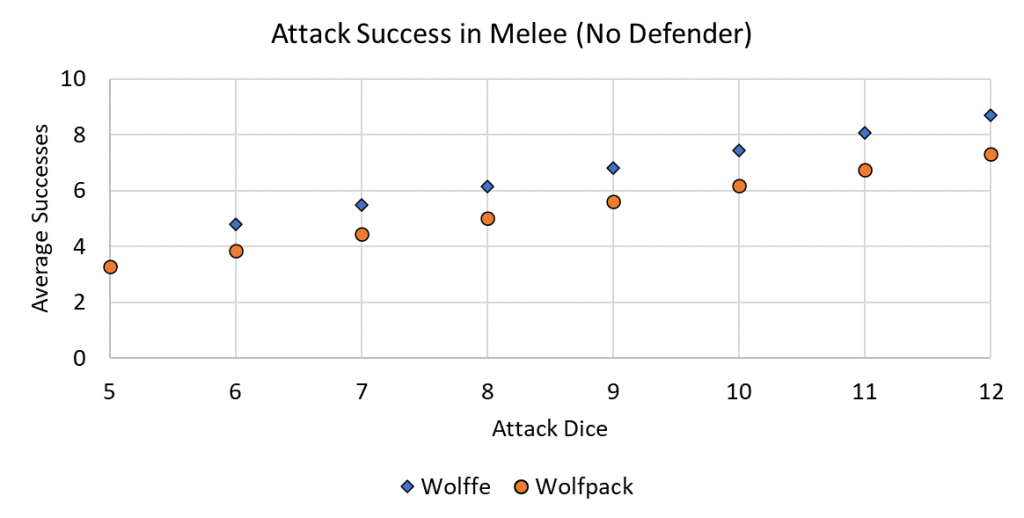
To look at marginal gains, I’m simply looking at the expected results added when we add an extra die. For example, if a character averages 4.5 successes on 6 dice and 5.2 on 7 dice, then the marginal gain of the 7th die is 0.7. When you examine the marginal gains for our Wolffe/Wolfpack examples, the data initially looks quite funky. The trends are a bit wavy due to random noise, most likely. The simulator runs 10,000 simulations and the average result changes by a few hundredths each time. The numbers are all close enough that this noise has an outsized influence, especially if one number is a bit low and the next a bit high, for example. I actually had to run each case a number of times then mentally compute the average, which helped dampen the noise a bit.
Generally speaking, it seems that Wolffe gets more value for each die compared to the Wolfpack, but his advantage is decreasing slowly the more dice we add. The Wolfpack are pretty much flat across all cases examined. These results aren’t too surprising – Wolffe has better expertise, but we’d expect that advantage to wane with more dice. Somewhat surprisingly, neither unit got particularly close to the limit of 0.5, even going from 11 to 12 dice. The Wolfpack get one more result at 4 expertise (compared to 3) while Wolffe gets a bump from 4 to 5 expertise. Even with dice pools as large as 12, it’s not like you’re getting 4+ expertise all that often (about 35% of the time, to be somewhat precise).
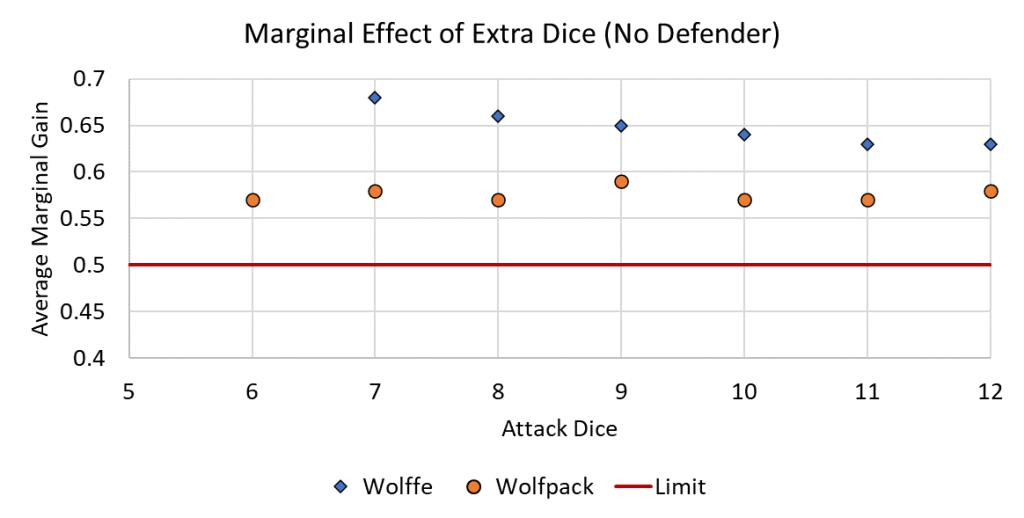
To add some excitement, let’s add in ARF and 501st. Their melee expertise charts max out after two and one expertise, respectively. It’s not really realistic for ARF or 501st to be adding tons of melee dice due to their abilities, but it’s still useful information. Any unit with the same expertise chart would yield the same results, ranged or melee. Once again, there’s some noise in these graphs. However, the trend is clear. ARF come out of the gate strong but quickly decrease in marginal gains since their expertise maxes out after two. Meanwhile, 501st actually approach the 0.5 limit since they almost certainly have the maximum one expertise result they can get.
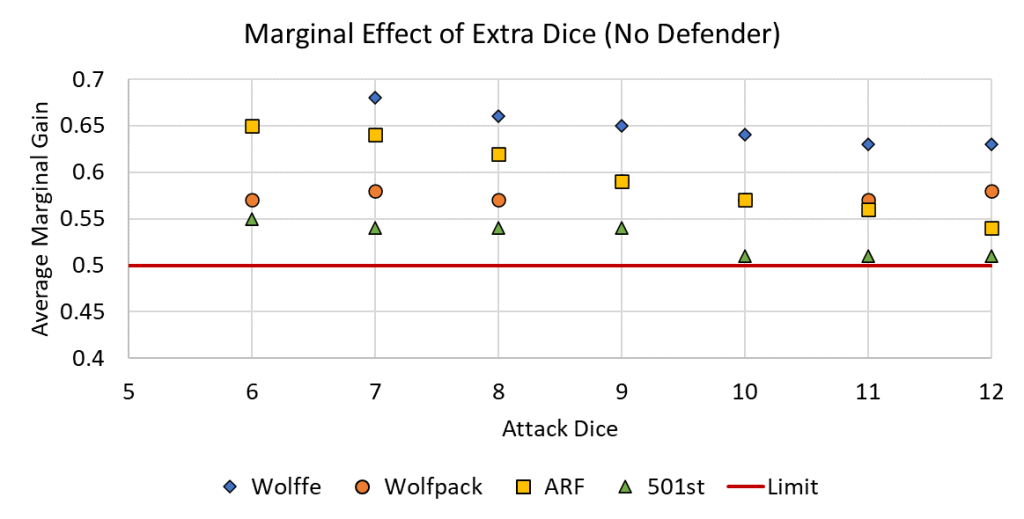
As discussed earlier, I want to examine the effect of a defender and the threshold that must be overcome due to blocks rolled.
We’ll start with Rex. His defensive expertise is fairly common and five dice is pretty middle-of-the-road. Going in I would expect that all units are pretty much exceeding his blocks from the get go, so we won’t see much of a threshold effect. That’s only sort of what we find. The units that don’t get many early results from expertise (Wolfpack, 501st) aren’t even gaining half a success per die in the early stages, suggesting they aren’t reliably exceeding Rex’s block count until 11 or 12 dice. Units with better early expertise (Wolffe, ARF) get significantly more value out of each die from the get-go.
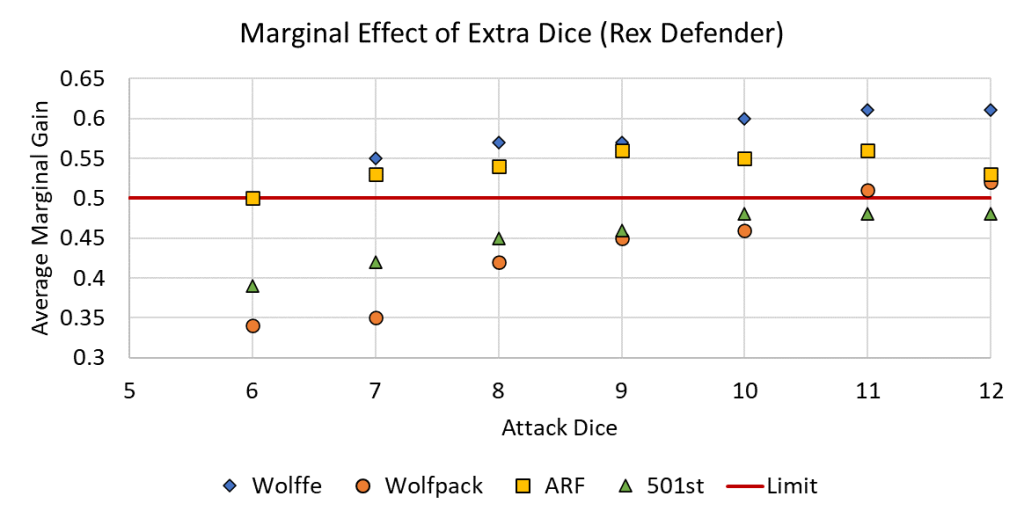
If we swap back to looking at average results instead of marginal gains, we see that Wolfpack still have a slight edge over the ARF at low dice counts. This is because the Wolfpack get crits from expertise. As I discussed the downside mitigation article, crits are king for raising the floor of an attack. However, if you want to really go deep in the tree, total successes are better.
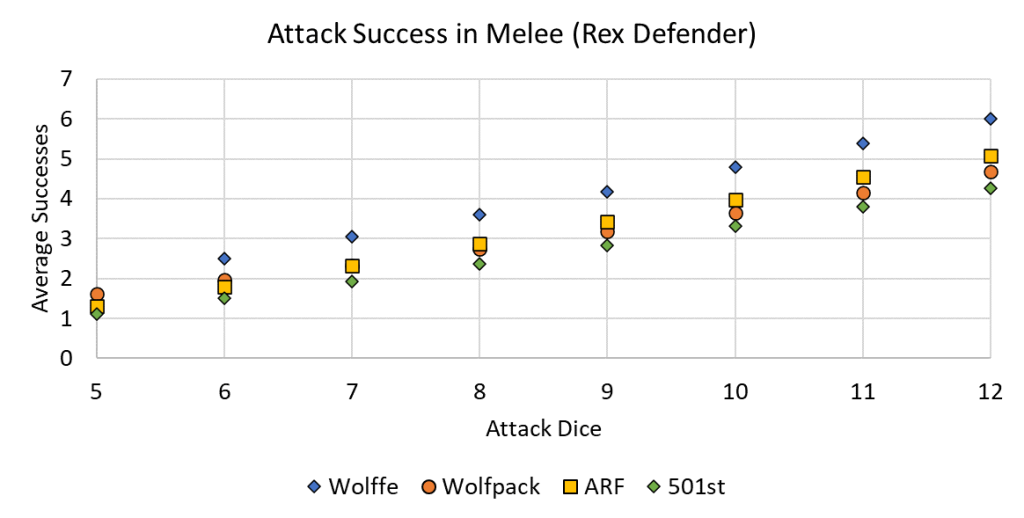
Before proceeding in the analysis, I feel like I should swap up my attackers. While the clones have served us well, I want to focus a bit earlier in the expertise tree. Going forward, I’ll use Rex (good right away, but not many added successes past that), Obi2 (scales decently), Mace (scales slowly) and Wolffe (beastly) for my attack expertise charts. I’ll examine each one from 5 dice up to 10.
We’ll up the ante a bit now and use MagnaGuards as our defender. Like Rex they get 5 dice, but their expertise is better, gaining two blocks on two results. Running the numbers we see a few interesting trends that I’ll posit explanations for. Somewhat surprisingly, everyone but Rex starts out with marginal gains lower than 0.5 when adding the sixth die. However, at six dice Mace and Wolffe are still getting the most damage through. Once again, we’re looking at the effects of crits. From the seventh die forwards, everyone gains similar benefits from added dice, except Mace who gains significantly less.
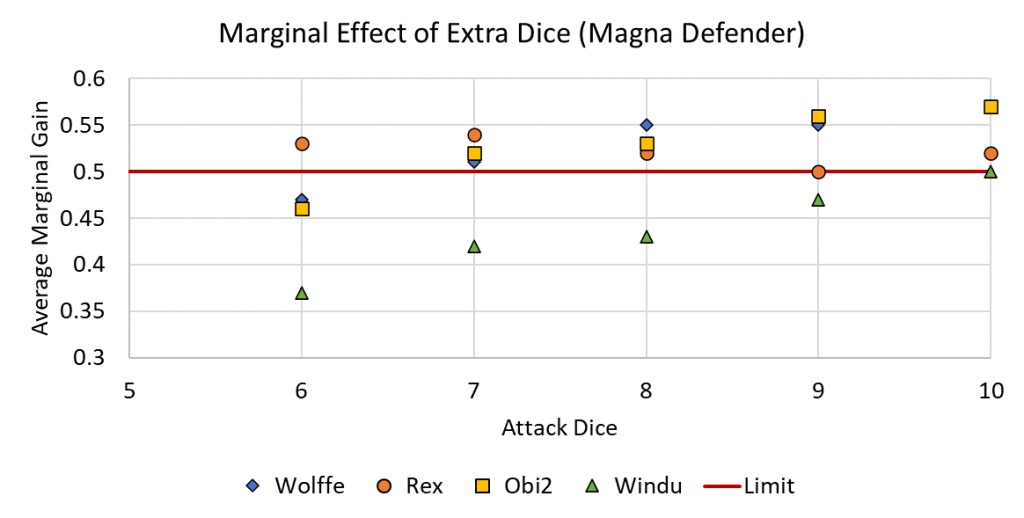
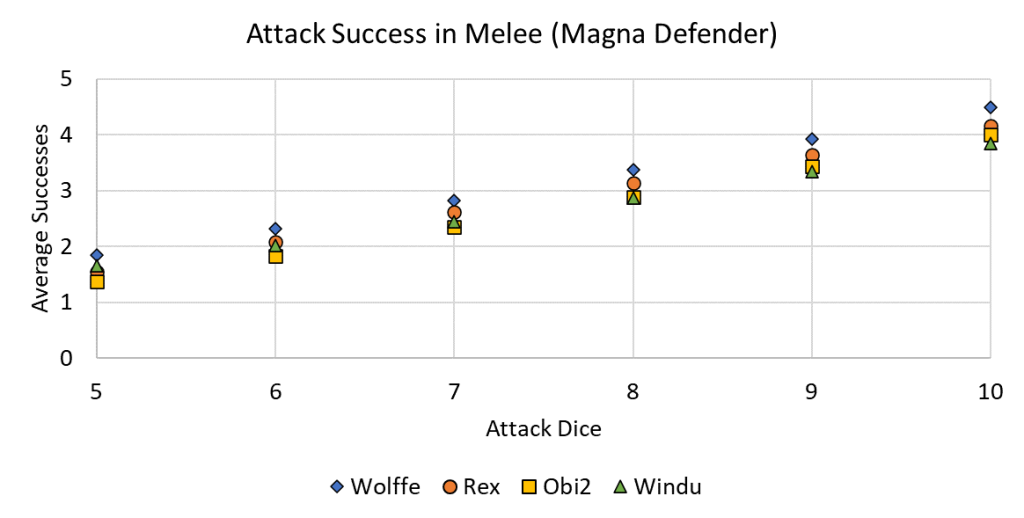
I originally planned to try again with Lumi as the defender, but I think we’ve seen enough. I have other things I want to examine as well. With the data so far, I feel comfortable making the following assertions:
When analyzing costs and benefits mid-game, points 3 & 4 are the main takeaways for me from this section.
I’ll be honest, I’ve never valued one extra defense die all that much. The Bodyguard ability is nice to have, but I don’t plan around it. An extra die in melee from an Obi hunker is cool, but I take Obi for the heals and dashes. However, stacking hunkers plus terrain cover (plus Bodyguard, for that matter) can add up. Some characters, like the Grand Inquisitor, can spend force for extra defense dice. Let’s take a quick look at the marginal gains of defense dice.
For the defensive expertise charts, I chose what I call “clone expertise” since it’s very common (one block on one, two blocks on three), Magna expertise for something a bit better, and Bo-Katan’s expertise for something even better still. I also included clone commandos because they have their expertise actually gets worse (from a block perspective) from two to three expertise and I’m just curious how that looks on the chart. To begin, I am legally obligated to show the chart that says “more dice are more better” just so there’s no confusion.
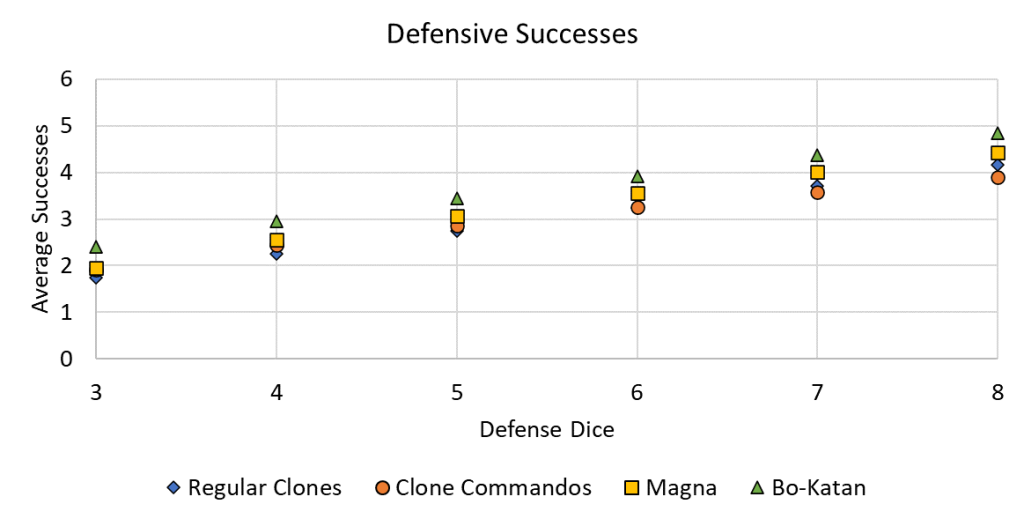
OK, looking again at marginal gains, there aren’t actually many huge differences, other than clone commandos. They get significantly less blocks per extra die than the other expertise charts investigated. That aside, I’m actually a bit surprised by these findings. Adding a fifth die to Bo-Katan, Magna (or something with their chart, since they natively have 5 dice) or an ARF clone, for example, gives them all about half a block. I’m surprised both by how high that is and how similar they all are to one another. I won’t dive deeper than this on defense today, but I will conclude this: better defensive expertise gives you a higher baseline, but most units will benefit similarly from the same increase in the defense dice.
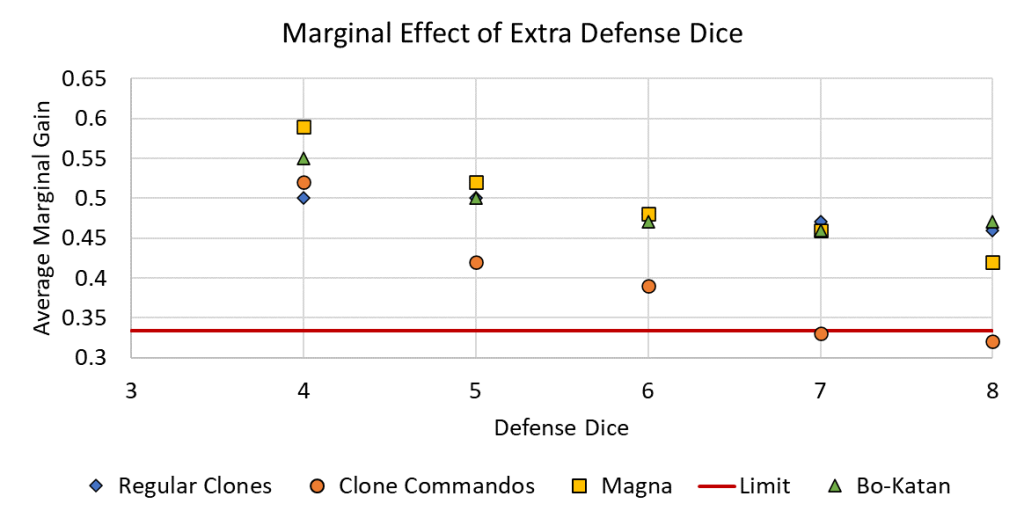
I said I’d do this at the start, so I must follow through! Since reroll and dice fixing effects mainly happen in Republic right now, I figure ARF should be a good example. They have a fine baseline attack and are very common in Republic lists. As such, the reroll is rerolling only blanks and the dice fixing we’ll use is turning a blank to a strike (Hunter’s identity). We’ll just be looking at average successes with no defender.
As a baseline, a seven dice, regular ARF attack averages about 4.61 successes. The marginal benefits of different modification effects are shown in the table below. The results are as I would expect: rerolls are worse than extra dice which are worse than dice fixing. Adding an extra die is always better than rerolling since we may not have failures to reroll. Additionally, each successive reroll we get has diminishing returns because we require even more failures in the initial roll. I expected dice fixing to be better than rolling one extra die, but I didn’t necessarily think the gap would be that big, just because you need a fail in the initial roll. Thinking back though, one fail is extremely common, so it makes sense that dice fixing adds a little under one strike on average.
| First Failure Reroll | 0.54 |
| Second Failure Reroll | 0.33 |
| First Added Die | 0.61 |
| Second Added Die | 0.60 |
| Fail-to-Strike Conversion | 0.87 |
Well, I’ve covered everything that I set out to investigate. It was an interesting journey, though I expected the results to be a bit more flashy than they were. I guess that makes it easier though, when things are relatively consistent you can make better rules of thumb. Hopefully you got something out of it that will help with decision making on the tabletop, I know I did! That’s good, because at the end of the day I don’t want throw around a lot of numbers and shrug. Also, I got to poke fun at Windu and Clone Commandos, two units which have annoyed me pretty much since release. That’s a win in my book!
While you’re here, why not check out the Adepticon spoilers recap article if you haven’t already? AMG outlined the releases for roughly the next twelve months and even showed off a few unit cards! Spicy stuff. I also continue to make YouTube videos over on Bombad Tactics, so check those out if you enjoy visual content!


Copyright © 2024 The Fifth Trooper. All Rights Reserved.